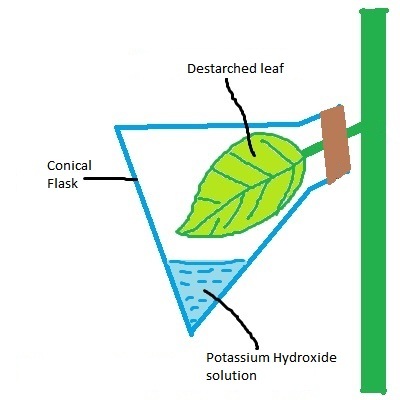7th Grade > Biology
NUTRITION IN PLANTS MCQs
:
Experiment steps: 1 Mark each
Inference: 1 Mark
1) A plant is selected and destarched by keeping it in darkness for 3 days. Pick a leaf and test it with iodine to confirm that the plant is starch free. It won't turn blue-black, which means it did not perform photosynthesis in the darkness and all the starch is used up by the plant.
2) Cover one leaf with black paper.
3) Expose the plant to sunlight for a day.
4) After a day, test the leaf covered with black paper using iodine. It will not turn blue-black as it has not synthesised starch, while the other uncovered leaves will now turn black-blue on the addition of iodine.
Inference: Photosynthesis did not occur in the leaf covered with black paper confirming the essentiality of light for the synthesis of starch.

:
Experiment steps: 1 Mark each
Inference: 1 Mark
For proving the necessity of carbon dioxide for photosynthesis, the following steps are performed:
1) A potted plant is taken and placed in complete darkness for 24 to 72 hours to destarch it.
2) Take potassium hydroxide in a conical flask stoppered with a rubber cork. Insert one leaf (still attached to parent plant) through a hole in the rubber cork. Potassium hydroxide absorbs all the left-over carbon dioxide from the flask.
3) The entire arrangement is exposed to sunlight for 6 hours.
4) The leaf placed in the conical flask with potassium hydroxide solution is tested with iodine solution. This does not turn blue-black.
Inference: The leaf trapped inside the conical flask did not perform photosynthesis as it did not receive any carbon dioxide. This is the reason why it did not answer a positive test for starch.

:
A
Nitrogen is present in abundance in gaseous form in the air. However, plants cannot absorb nitrogen in this form. Elemental nitrogen is converted into oxides of nitrogen by bacteria like Rhizobium, which can then be used by plants.
:
A
Algae contain chlorophyll and can prepare their own food by the process of photosynthesis in the presence of sunlight, utilising carbon dioxide and water.
:
A, B, and C
Cacti (singular: Cactus), in order to survive in extremely dry weather, show certain types of modifications of the plant parts. These modifications are known as adaptations. Few of them are as follows:
1. Leaves are turned into spines.
2. Stems are modified to store water.
3. Root system is well developed.
:
B
Only the plants containing chlorophyll can perform photosynthesis. There are a few plants which cannot prepare their own food and they live on other host plants as parasites and obtain their nutrients from them. Cuscuta is one such plant.
:
C
The organelle that helps in capturing sunlight is known as chloroplast. These chloroplasts contain chlorophyll, a green pigment, that captures sunlight in order to perform photosynthesis.
:
B
There are certain organisms which can make their own food and are called autotrophs. They utilise carbon dioxide and water in the presence of sunlight and chlorophyll and make their food in the form of glucose. This process is known as photosynthesis.
:
B
The plant on which Cuscuta grows on for support is called a host. Cuscuta is a parasitic plant which obtains its required nutrients from the host plant.
:
C
Gases are exchanged in plants through small openings called stomata. Stomata is present mostly on the lower surface of leaves and on green stems. Each stoma has two bean-shaped cells called guard cells, which controls the opening and closing of the stomata.
















